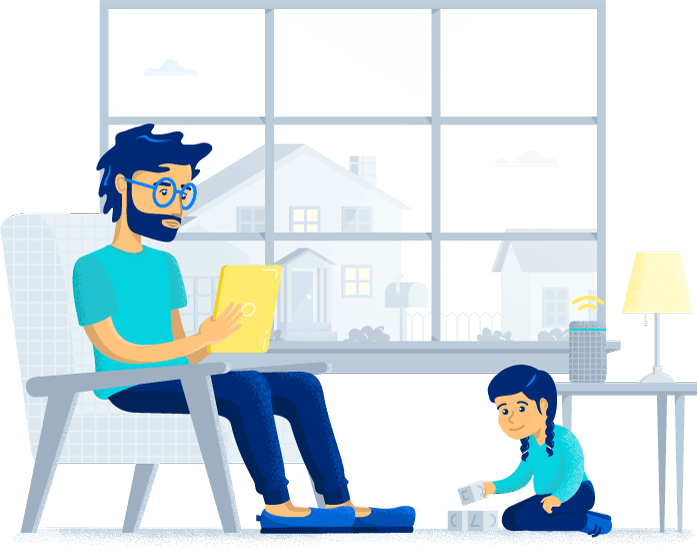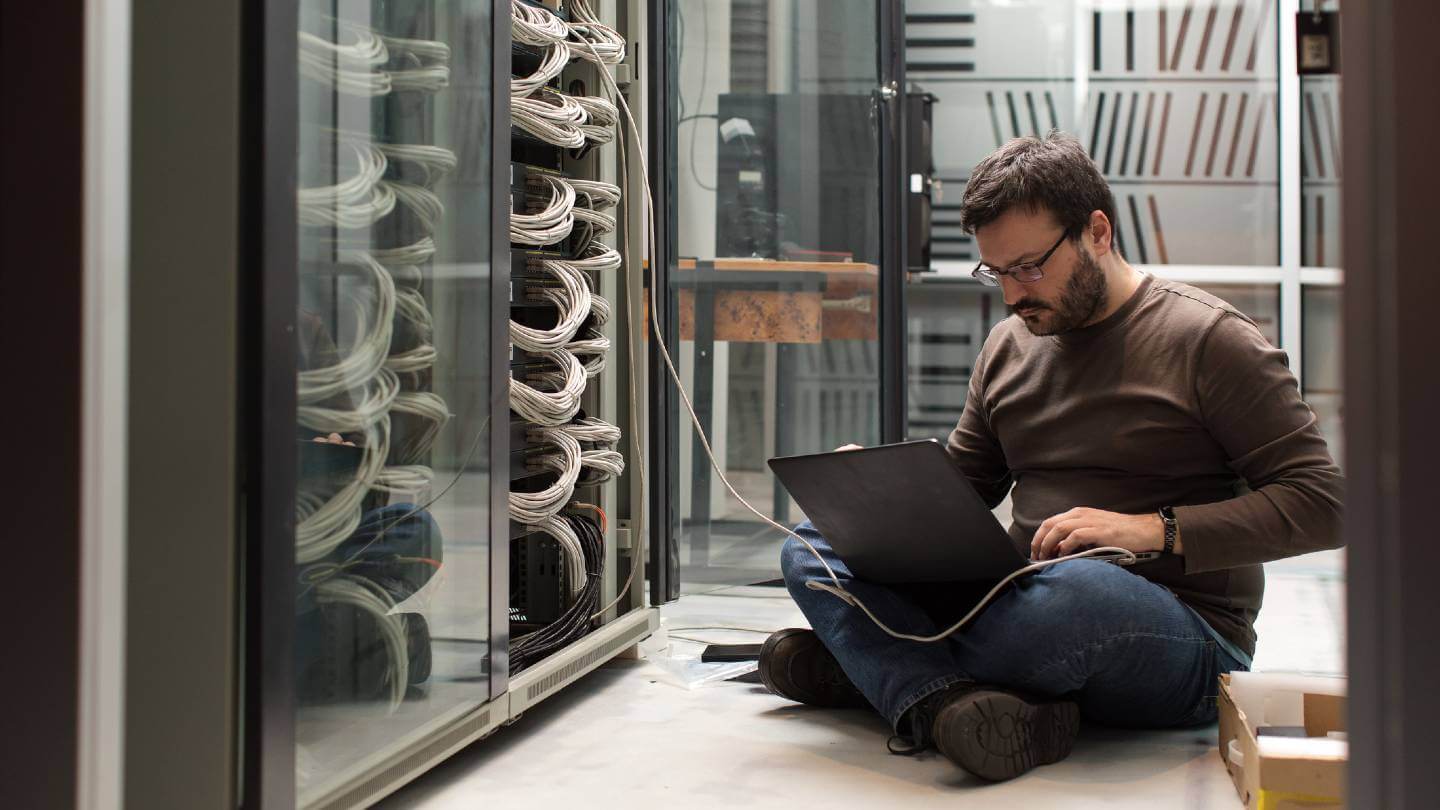When it comes to internet, “fast” is a relative term. For years the Federal Communications Commission’s broadband speed standard was 25 Mbps download and 3 Mbps upload. You’d have trouble watching Netflix, participating in Zoom calls or using a video doorbell with those speeds. Today, that standard is 100 Mbps download and 20 Mbps upload, though many providers offer much faster speeds.
While the minimum broadband standard has risen drastically since the FCC’s old broadband benchmark, we’re still just scratching the surface of fast internet. Here’s how the top internet connection types compare when it comes to their potential for speed.
Fiber optic internet
Fiber optic is by far the fastest type of internet available today. Some regional providers, like EPB in Chattanooga, TN, offer speeds all the way up to 10 Gbps, and multi-gig plans are available from most fiber internet providers.
Believe it or not, those speeds are only scratching the surface of what fiber optic internet could theoretically do. In July 2021, researchers at Japan’s National Institute of Information and Communications Technology smashed the internet speed record, transmitting data over 1,800 miles at 319 Terabits (or 319,000,000 Megabits) per second.
The researchers achieved speeds about 319,000 times faster than the 1 Gbps plans commonly available, and twice as fast as the previous world record. To put it in perspective, that’s enough speed to download every title on Netflix in under half a second.
What’s even more impressive is that they did it using fiber optic infrastructure that already existed, just with a few advanced add-ons. As a report in Interesting Engineering noted, “Not only have the researchers in Japan blown the 2020 record out of the proverbial water, but they’ve done so with a novel engineering method capable of integrating into modern-day fiber optic infrastructure with minimal effort.”
How fast is fiber internet?
Fiber internet speeds can range from 100 – 10,000 Mbps, depending on your provider. Some of the most popular fiber providers are AT&T, which offers speeds from 300 – 5,000 Mbps, and Verizon Fios, which offers 300 – 2,000 Mbps. Explore some other popular fiber providers and their speed ranges below.
| Provider | Price range* | Download speed range | Rating |
|---|---|---|---|
| Google Fiber | $70.00 – $100.00/mo. | 1,000 – 2,000 Mbps | 4.50/5 |
| AT&T | $55.00 – $250.00/mo.** | 300 – 4,700 Mbps | 4.43/5 |
| Verizon Fios | $49.99 – $109.99/mo. | 300 – 2,000 Mbps | 4.42/5 |
| CenturyLink | $50.00 – $75.00/mo. | 200 – 940 Mbps | 4.33/5 |
| Frontier Fiber | $39.99 – $154.99/mo. | 500 – 5,000 Mbps | 4.27/5 |
| Xfinity | $75.00 – $299.95/mo. | 3,000 – 6,000 Mbps | 3.57/5 |
| Windstream | $39.99 – $299/mo. | 200 – 8,000 Mbps | 3.95/5 |
| Cox | $50.00 – $150.00/mo. | 1,000 – 2,000 Mbps | 3.56/5 |
| Optimum | $40.00 – $180.00/mo. | 300 – 5,000 Mbps | 4.18/5 |
| Ziply Fiber | $10.00 – $300.00/mo. | 100 – 10,000 Mbps | 3.71/5 |
| Sparklight | $50.00 – $110.00/mo. | 200 – 1,000 Mbps | 3.73 |
| Earthlink | $54.95 – $99.95/mo. | 100 – 1,000 Mbps | 3.01 |
| WOW | $30.00 – $95.00/mo. | 100 – 5,000 Mbps | 4.00/5 |
| Spectrum | $49.99 – $89.99/mo. | 300 – 1,000 Mbps | 3.67 |
*Pricing per month plus taxes for length of contract. Additional fees and terms may apply. Pricing varies by location and availability. All prices subject to change at any time. May or may not be available based on service address. Speeds may vary. As of 03/21/24.
**Price after $5/mo Autopay & Paperless bill discount (w/in 2 bills). Monthly State Cost Recovery Charge in TX, OH, NV applies. One time install chrg may apply.
Cable internet
Cable internet connections sit somewhere in the middle in the internet hierarchy: faster than DSL and satellite, but behind fiber. These connections utilize coaxial cables, which are made of copper, instead of fiber optic cables, which use small, flexible strands of glass or plastic.
Because it’s a less efficient way to transmit data, cable internet has a lower bandwidth limit than fiber optic connections. According to the Electronic Frontier Foundation, connections that use coaxial cables can theoretically transmit about 10 Gbps today, but that’s under ideal conditions — data sent to one place instead of the dozens or hundreds of homes it would realistically be shared with. Cable internet also has lower upload speeds than fiber internet, which boasts symmetrical upload and download speeds.
How fast is cable internet?
Below are the top cable ISPs in the country and their internet speed ranges. While cable speeds are more than enough to satisfy heavy internet users, fiber connections are still faster and more reliable, especially when it comes to upload speeds.
| Provider | Speed range | Starting monthly price range* | Monthly data cap |
|---|---|---|---|
 Breezeline Breezeline | 100 – 1,000 Mbps | $19.99 – $59.99 | None |
 Buckeye Broadband | 200 – 1,000 Mbps | $39.99 – $159.99 | None |
 Cox | 100 – 2,000 Mbps | $50.00 – $150.00 | 1 TB |
 Mediacom | 100 – 1,000 Mbps | $24.99 – $54.99 | 200 GB – 6 TB |
 Optimum | 300 – 5,000 Mbps | $40.00 – $180.00 | None |
 Shentel | 50 – 1,000 Mbps | $40.00 – $175.00 | 500 GB – 3 TB |
 Sparklight | 200 – 1,000 Mbps | $50.00 – $110.00 | 700 GB – Unlimited |
 Spectrum | 500 – 1,000 Mbps** | $50.00 – $70.00 | None |
 Xfinity | 50 – 6,000 Mbps | $24.99 – $299.95 | 1.2 TB |
*Pricing per month plus taxes for length of contract. Additional fees and terms may apply. Pricing varies by location and availability. All prices subject to change at any time. May or may not be available based on service address. Last updated 3/21/24.
**Wireless speeds may vary.
![]()
High-bandwidth broadband over coax is possible, but we are approaching the limits of what the technology can do.
Coaxial connections could potentially hit speeds of up to 50 Gbps, but it’s unlikely we’ll ever see that in practice, as almost all new investment goes towards fiber optic infrastructure. Several cable internet providers, like Spectrum and Xfinity, offer gig speeds, but they use hybrid fiber-coaxial cable connections to deliver them. A purely coaxial cable connection wouldn’t be able to reach those speeds for residential customers.
DSL internet
DSL, short for digital subscriber line, is one of the most widely available types of internet service in the U.S., but it’s also one of the slowest. With DSL, providers use fiber optic or coaxial cables to run internet to local service hubs, where it’s carried to your home through your telephone line.
In some areas, DSL connections can reach speeds up to 100 Mbps, but most plans top out around 30 Mbps. Even more than fiber and cable internet, the speed of DSL connections largely depends on how close you are to the service hub. Even though DSL uses a phone line, it is a major upgrade from dial-up internet, as it lets you use your phone and internet simultaneously.
How fast is DSL internet
DSL internet caps out around 100 Mbps, with most of the DSL providers still around offering less than that. It’s safe to say DSL is the slowest internet tech type today with the high-speed options we have from cable and fiber internet.
| Providers | Starting price* | Max speed range | Data caps |
|---|---|---|---|
AT&T | $55.00/mo. | 10 – 100 Mbps | 1.5TB/mo. |
Verizon DSL | $49.99/mo. | 0.5 – 15 Mbps | None |
CenturyLink | $55.00/mo.** | Up to 100 Mbps | None |
Frontier | $64.99/mo. | Varies | None |
| Kinetic by Windstream | $39.99/mo. | Up to 100 Mbps | None |
*Pricing per month plus taxes for length of contract. Additional fees and terms may apply. Pricing varies by location and availability. All prices subject to change at any time. May or may not be available based on service address. Speeds may vary. As of 03/15/24. **Rate requires paperless billing. Additional taxes, fees, and surcharges apply. Not all DSL speed tiers are available to each customer. These speeds depend on your proximity to the central connection point in your service location, so some households will receive faster speeds than others. 03/21/24
FAQs
Allconnect: Let us compare providers for you
Why should you choose Allconnect? We’re the #1 broadband marketplace in the U.S, meaning you can trust us to search, compare and order internet and TV service for your home.
Get started

Written by:
Joe SupanPrincipal Writer, Broadband Content
Joe is a senior writer for CNET covering home technology and broadband. Prior to joining CNET, Joe led MYMOVE’s moving coverage and reported on broadband policy, the digital divide, and privacy issues for the br…
Read more
Edited by:
Robin LaytonEditor, Broadband Content
-
Featured
![Advertised vs. actual internet speeds — Are you getting the internet speeds you pay for?]() Advertised vs. actual internet speeds — Are you getting the internet speeds you pay for? Joe Supan — 5 min read
Advertised vs. actual internet speeds — Are you getting the internet speeds you pay for? Joe Supan — 5 min read -
Featured
![Tips to improve your internet connection and boost Wi-Fi signal]() Tips to improve your internet connection and boost Wi-Fi signal Camryn Smith — 9 min read
Tips to improve your internet connection and boost Wi-Fi signal Camryn Smith — 9 min read -
Featured
![What is a good internet speed?]() What is a good internet speed? Camryn Smith — 7 min read
What is a good internet speed? Camryn Smith — 7 min read
Latest
-
Wednesday, October 23, 2024
What is my IP address and why does it matter?Camryn Smith — 3 min read
-
Tuesday, October 22, 2024
Everything you need to know about internet speedsRobin Layton — 5 min read
-
Tuesday, October 22, 2024
How to change your Wi-Fi network passwordCamryn Smith — 3 min read






